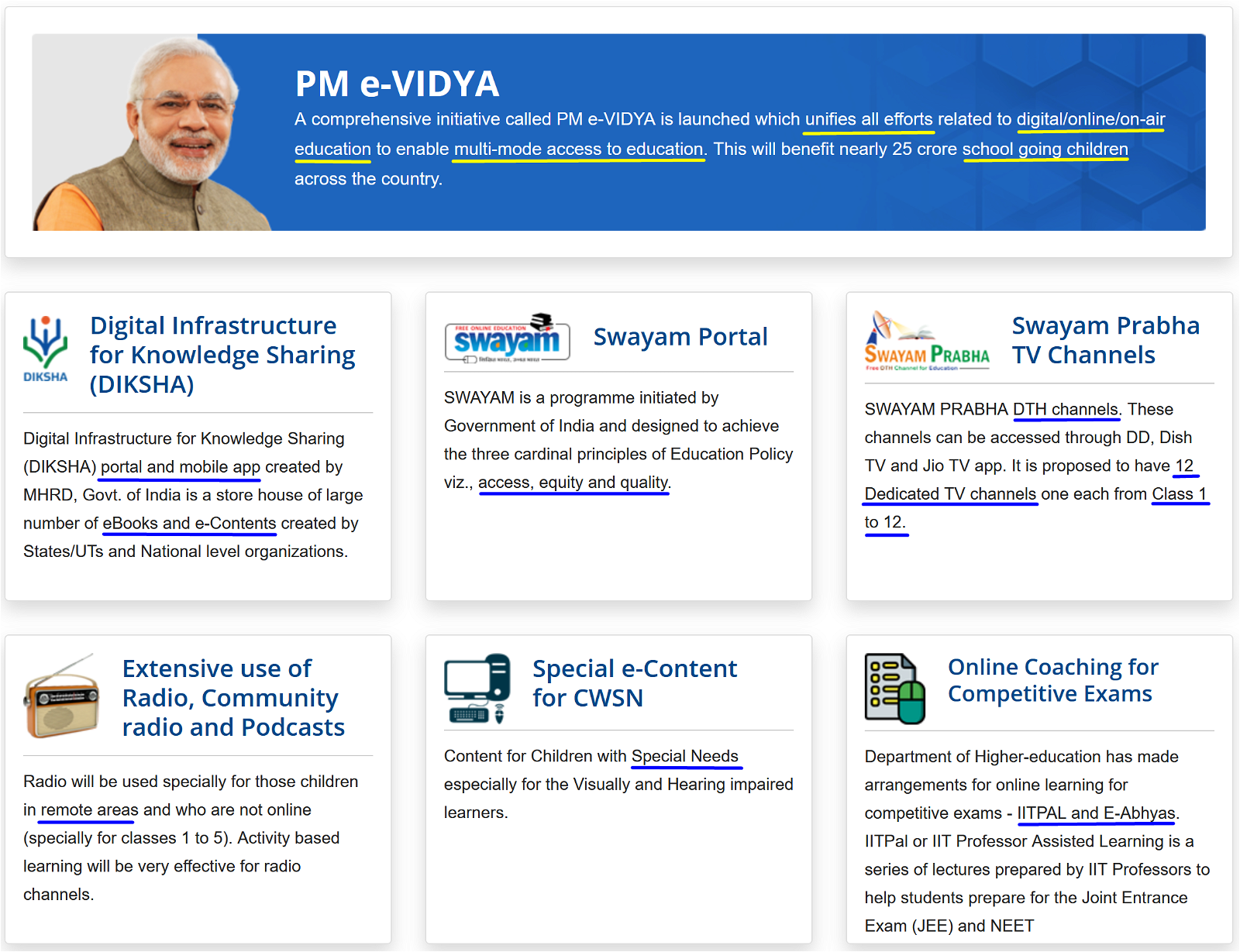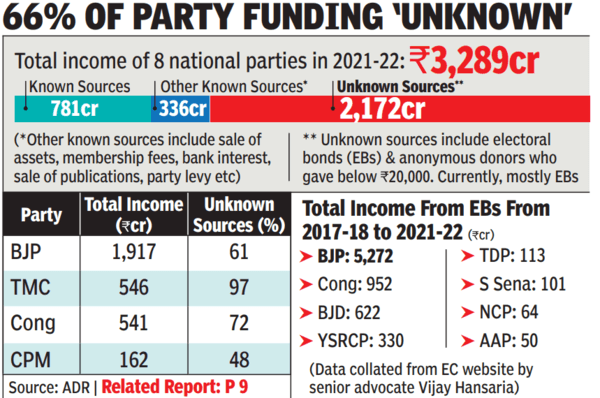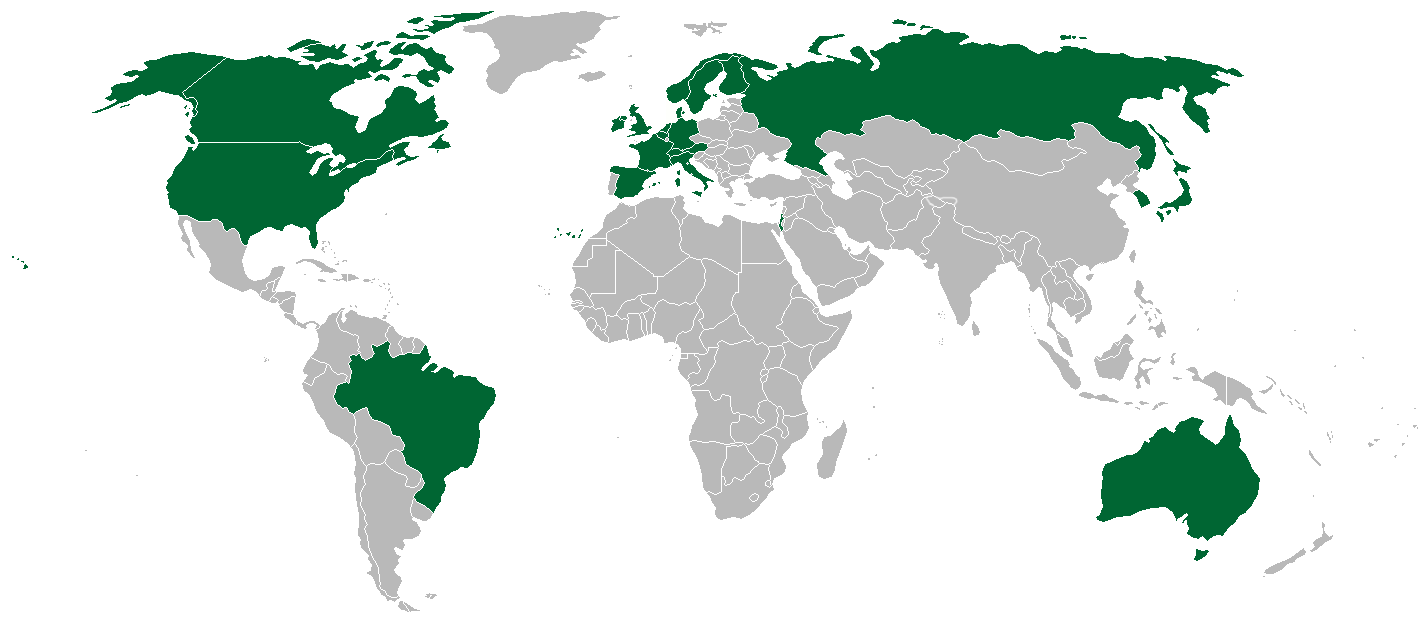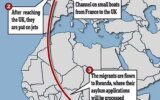
Current Affairs February 14, 2024: Autoimmune Diseases, Report on Epidemic Diseases Act, 1897, Violation of STs Rights, Human-Wildlife Conflict, Wheat Blast, Aral Sea, Alaskapox, Gupteshwar Forest, Data Exclusivity, NGDRS Project
Subscribers of "Current Affairs" course can Download Daily Current Affairs in PDF/DOC
Subscribe to Never Miss an Important Update! Assured Discounts on New Products!
Must Join PMF IAS Telegram Channel & PMF IAS History Telegram Channel
{GS2 – Governance – Initiatives} NGDRS Project
- Context (PIB): The National Generic Document Registration System (Blockchain application) & Unique Land Parcel Identification Number were recently launched in Assam as a pilot project.
National Generic Document Registration System (NGDRS)
- The NGDRS project was initiated by the Department of Land Resources, Ministry of Rural Development, Government of India.
- It is a common, generic application developed for registration departments across the country under the One Nation, One Software initiative.
- It was developed by the National Informatics Centre (NIC) in Pune.
- The application enables citizens to proceed with buying land online.
- They can find out the circle rate for land, calculate property valuation as per prevailing rates and understand the type of land.
- Transactions of prohibited properties are restricted for sale like government land, tribal land, mortgaged land etc., is also available, which ultimately helps them decide where and what type of land they should buy.
- Property buyers need to visit the sub-registrar’s office only once, i.e. at the time of final signing and registration.
Unique Land Parcel Identification Number (ULPIN)
- The land parcel is uniquely identified using ULPIN. It is taken as the unique blockchain ID.
- ULPIN is a 14-digit alphanumeric identification number for every land parcel. It can be described as the AADHAR or fingerprint for land.
|
{GS2 – Social Sector – Health – Diseases} Autoimmune Diseases
- Context (IE): A recent study delves into the connection between autoimmune diseases and X-chromosomes, offering insight into why women are more susceptible to such disorders.
Linkage between X Chromosome and Autoimmune Diseases
- Females have two X chromosomes, while males have one X and one Y.
- The second X chromosome in females contains both active and inactive genes.
- The molecular coating of the X chromosome is a combination of RNA and proteins.
- It is crucial to a process called X chromosome inactivation, which ensures that one set of X chromosomes in females remains active and functional while the other is muffled.
- The chromosome is wrapped in long strands of RNA called XIST that attract proteins and tamp down the expression of the gene inside.
- The ones that escape the X inactivation process are thought to be the cause of autoimmune diseases.
- The XIST molecule, too, has been known to elicit inflammatory immune responses.
Autoimmune Diseases (AD)
- It occurs when the immune system mistakenly targets healthy cells and tissues in the body.
- Examples of AD: Rheumatoid Arthritis, Systemic Lupus Erythematosus, Type 1 Diabetes, Multiple Sclerosis, Celiac Disease, Hashimoto’s Thyroiditis, Psoriasis, and Inflammatory Bowel Disease.
- AD is more common in females, with a female-to-male ratio ranging from 10:1 to 1:1.
- They can occur at any age but are more common during the reproductive years.
- The presence of one AD in an individual increases the risk of developing another AD by 30-40%.
- Symptoms: Fever, malaise, fatigue, arthralgia, deformity, disability, increased risk of comorbidities like cancer, stroke, mental illnesses, infections and risk of early mortality.
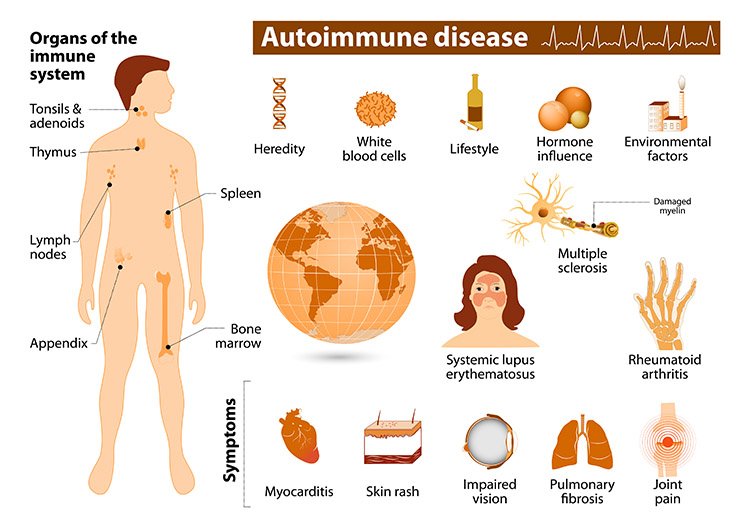
Types of Autoimmune Diseases
- Organ-specific disease (involving only one organ) in which the immune response is directed toward antigens present in a single organ.
- E.g. Autoimmune thyroiditis, multiple sclerosis, Diabetes Mellitus Type I, etc.
- Systemic disease in which the immune system attacks self-antigens in several organs.
- E.g. Systemic lupus erythematosus is characterised by inflammation of the skin, mucus membranes, joints, kidneys, brain, intestines, etc.
What causes Autoimmune Diseases?
- Genetics: A family history of autoimmune diseases suggests a genetic predisposition, with specific genes increasing susceptibility to such disorders.
- Environmental Factors:
- Microorganisms (bacteria or viruses) may trigger changes that confuse the immune system.
- Epigenetic factors, which interact with genes, can also play a role.
- Hormonal Influence: Estrogen, a female sex hormone, has an impact on the immune system, and imbalances or inflammation in estrogen levels can heighten the risk of AD in women.
- Medications: Some medications can induce changes in the body that confuse the immune system; for instance, side effects of statins, antibiotics, and blood pressure medications may play a role.
{GS2 – Social Sector – Health} Epidemic Diseases Act, 1897
- Context (PIB | IE): The Law Commission of India submits a Report titled “A Comprehensive Review of the Epidemic Diseases Act, 1897.“
- As per the Law Commission, the existing legislation exhibits “significant deficiencies” in addressing the containment and management of future epidemics as new infectious diseases or novel strains of existing pathogens may emerge.
Epidemic Diseases Act, 1897
- The colonial government introduced the Act to tackle the epidemic of bubonic plague that had spread in the erstwhile Bombay Presidency in the 1890s.
- Objective: To provide “for the better prevention of the spread of Dangerous Epidemic Diseases.”
Provisions of the Act
- Section 2 empowers state governments/UTs to take special measures and formulate regulations for containing the outbreak.
- Section 3 provides penalties for disobeying any regulation or order made under the Act. These are punishable under section 188 of the Indian Penal Code.
- Section 4 gives legal protection to the implementing officers acting under the Act.
Limitations of the Act
- The Epidemic Diseases Act,1897, does not define an ‘epidemic’ disease or an ‘infectious’ disease.
- It does not differentiate between an ‘outbreak’, ‘epidemic’ and ‘pandemic’ due to which, there is no line of clarity on the criteria for declaring an epidemic and invoking the said Act.
- It does not appropriately decentralize and demarcate the power between the Centre, State and local authorities to regulate the epidemic situation.
- It does not specifically stipulate the procedure and guidelines that will be followed pertaining to isolation and quarantine.
- The Act lacks a synchronized framework between public and private diagnostic laboratories and fails to address the primary question as to who can conduct and regulate the diagnosis.
- The Act makes no mention of specific regulations for the safe disposal of infectious medical waste and human corpses.
- It is also silent on authentic information dissemination systems regarding epidemic diseases which become imperative to control further spread and to notify current status of disease.
Recommendations of Law Commission
- Creation of an Epidemic Plan to address future epidemics.
- Duty to create this Epidemic Plan falls on the Central government in collaboration with state governments after consultation with the ministries concerned, private health institutions, expert bodies, and other stakeholders.
- Plan should include provisions on quarantine, isolation, and lockdowns.
- Creation of a Standard Operating Procedure (SOP) to enforce the Epidemic Plan to “ensure proper and coordinated response to any epidemic with pre-defined powers and roles in case of a public health emergency”.
- The difference between ‘quarantine’ and ‘isolation’ should be clarified by appropriately defining these terms.
{GS2 – Vulnerable Sections – STs} Violation of Rights
- Context (TH): Earlier this month, the notification of the Thanthai Periyar Sanctuary in Erode district of Tamil Nadu caused concern among nearby forest-dwellers.
- They fear it could lead to the denial of their rights under the Scheduled Tribes and Other Traditional Forest Dwellers (Recognition of Forest Rights) Act 2006 (FRA).
Issue
- Cattle grazers can no longer graze in the Thanthai Periyar Sanctuary.
- Bargur cattle, a traditional breed native to the Bargur forest hills, may now be prevented from accessing their traditional grazing grounds.
- Six tribal forest villages were denied basic rights and facilities because these are not revenue villages. However, under FRA all forest villages are to be converted to revenue villages. These rights continue to be denied.
- Tamil Nadu has been one of the most laggard States in implementing the FRA in the country.
Forest Rights Act 2006 (FRA)
- It acknowledges the rights of nomadic or pastoralist communities, including grazing (both settled or transhumant) and traditional seasonal resource access, in all forests, including National Parks, Sanctuaries, and Tiger Reserves.
- Grazing rights are community rights of the habitation-level villages and are to be regulated by their gram sabhas.
- The FRA violations, in the case of Scheduled Tribes, are also crimes under the 2016 amendment to the Scheduled Castes and the Scheduled Tribes (Prevention of Atrocities) Act, 1989.
Wildlife (Protection) Act, 1972
- In Sanctuaries, people retain their rights unless restricted, but in National Parks, they do not.
- No new rights are permitted once the notice of intent is issued.
- The Collector is to inquire into the rights of all persons, their nature and extent, in the proposed Sanctuary or National Park.
- Then, the Collector’s office must decide whether to admit the claims in Sanctuaries and to acquire all rights in National Parks.
- The law mandates similar procedures when some land is initially notified as forests.
Thanthai Periyar Sanctuary
- It is located between the Sathyamangalam Tiger Reserve of Tamil Nadu and the Male Mahadeshwara WLS and the Cauvery WLS of Karnataka.
- It is positioned where the Eastern Ghats merge with the Western Ghats at the Nilgiris.
- It is identified by the National Tiger Conservation Authority (NTCA) as one of the tiger corridors and is also incorporated within the Nilgiris Elephant Reserve.
- It is drained by the Palar River, which contributes to the Cauvery River ecosystem.
- Notable fauna includes tigers, Indian gaur, elephants, leopards, wild boars, and deer.
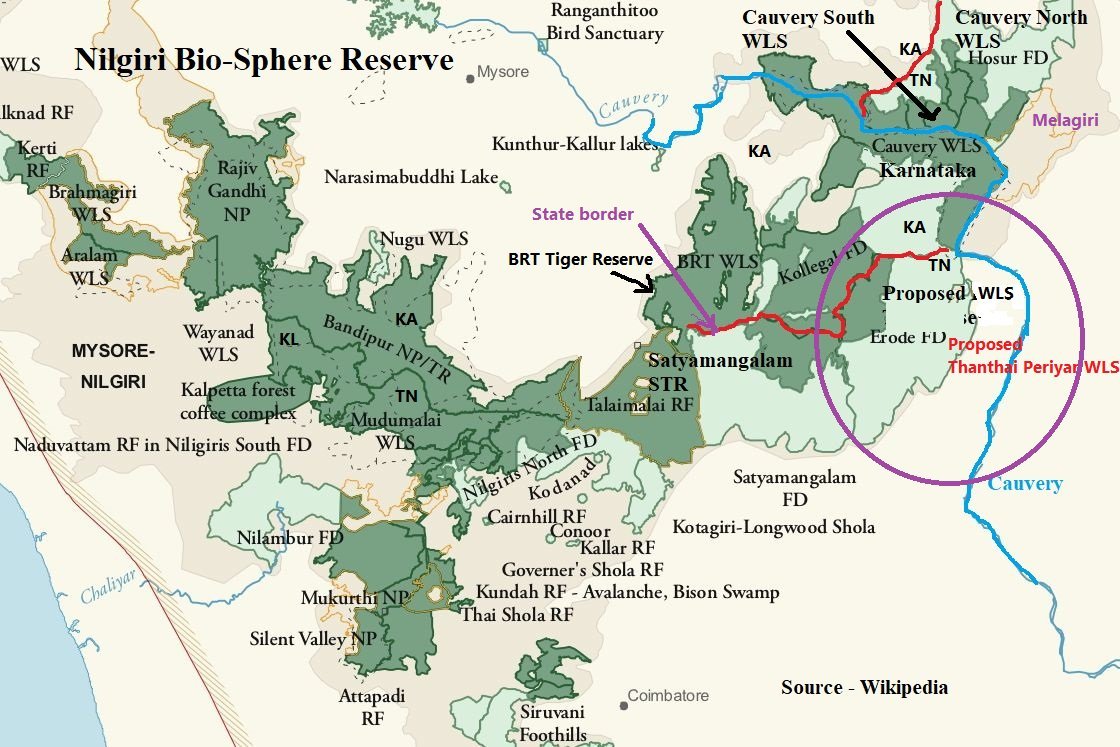
{GS3 – Agri – Crops} Wheat Blast
- Context (DTE): Recent study established concerning link between climate change and wheat blast.
- Currently, it affects 6.4 million hectares of cropland globally.
- By 2050, climate change is projected to exacerbate the situation, putting 13.5 million hectares of cropland at risk.

Wheat Blast (WB)
- It is a fungal disease caused by the pathogen Magnaporthe oryzae pathotype Triticum (MoT).
- It was first identified in Brazil in 1985.
- It is a fast-acting and devastating disease that poses a significant threat to wheat crops, particularly in tropical and subtropical regions.
Symptoms
- Progressive bleaching of heads, where infected spikes show a silvery appearance with a green canopy, turning partially or fully bleached in severe cases.
- Infected plants exhibit discoloured stems and leave with dark brown lesions and visible dark grey fungal spores.
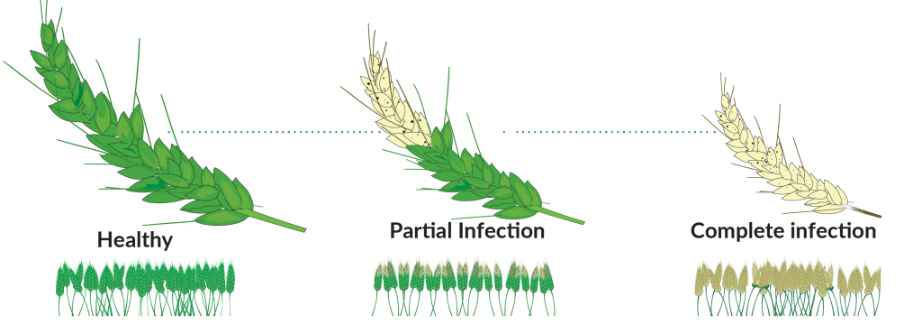
How does it spread?
- It spreads via infected seeds, posing threat to new crops as the fungus can persist within them.
- Airborne spores are key in wheat blast transmission, travelling long distances and swiftly infecting nearby wheat fields upon release.
- Infected crop residues containing the fungus aid in disease spread by surviving and infecting new plants under favourable conditions.
- Warmer temperatures and prolonged leaf moisture aid wheat blast pathogen spread, fostering disease growth.
- Also, international wheat trade has been a cause in some countries like Bangladesh and Zambia.
Implications
- It leads to significant yield reductions, with projections indicating a potential 13% global wheat production decrease.
- Vulnerable regions like South America and Africa could face up to 75% of their wheat acreage at risk by 2050.
- WB can incur significant economic losses in certain countries.
- Vulnerable wheat-growing regions in Bangladesh, India, and Pakistan could incur potential losses of 886 thousand metric tons of wheat production, amounting to USD 132 million annually.
- E.g. During the 2016 outbreak, an estimated total wheat production loss of approximately 8,205 tons, worth USD 2.1 million, was recorded.
- The spread of WB poses a threat to global food security, particularly in regions experiencing growing wheat consumption.
Way Forward
- Develop and promote wheat varieties resistant to WB.
- Combine race non-specific resistance genes to enhance durability.
- Fungicide spray applications can help manage WB.
- Strictly regulate the movement of contaminated plant material and farm equipment.
- Implement practices to break the disease cycle.
- Properly manage crop residues to reduce disease transmission.
- Use early warning systems to predict disease outbreaks.
- Investigate biological control agents to suppress WB (Beneficial microorganisms or natural enemies can play a role).
{GS3 – Envi – Conservation} Human-Wildlife Conflict
- Context (IE): In Wayanad, a radio-collared wild elephant chased a 47-year-old man and trampled him to death, inside a gated property in a residential area.
- Human-wildlife conflict is when encounters between humans and wildlife lead to negative results, such as loss of property, livelihoods, and even life.
- It is a serious global threat to sustainable development, food security, conservation, and health that is negatively affecting both people and wildlife and hindering the achievement of many SDGs and the Aichi Biodiversity Targets.
- Human-wildlife conflict is recognised as a global concern in the UN Convention on Biological Diversity’s post-2020 global biodiversity framework.
Status of Human-Wildlife Conflict
- Government data for 2022-23 recorded 8,873 wild animal attacks, of which, 4193 were by wild elephants, 1524 by wild boars, 193 by tigers, 244 by leopards, and 32 by bison.
- From 2017 to 2023, there were 20,957 incidents of crop loss due to wild animal raids which also killed 1,559 domestic animals, mainly cattle.
Causes
- Increasing encroachment on wildlife habitats.
- Decline in the quality of forest habitats, largely due to the cultivation of alien plants — mainly acacia, mangium and eucalyptus — in forest tracts for commercial purposes.
- Changing agri-practices were also responsible for drawing animals, which do not find enough fodder in their habitats, out of forests.
- Waste disposal near forested areas.
- Fragmentation of animal habitats due to wanton construction.
- Increased human presence in and around animal habitats.
Consequences
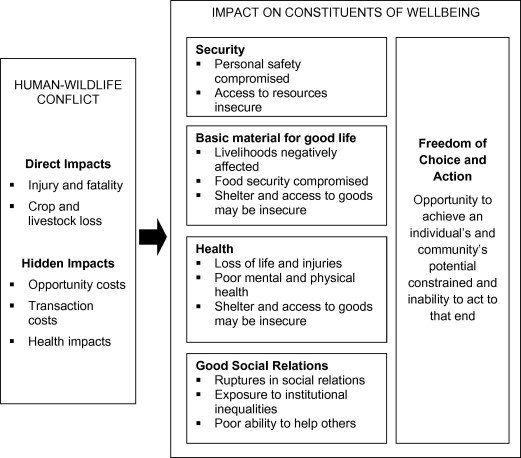
Way Forward
- Relocating man-eating animals to new wildlife zones where the population is less.
- Re-developing corridors connecting habitat and sensitising people on how to deal with animals.
- Forming primary response teams of locals in all panchayats sharing forest boundaries.
{GS3 – S&T – IPR} Data Exclusivity
- Context (TH): A clause in the draft FTA between India and the European Free Trade Association (EFTA) may delay access to affordable generic versions of patented drugs in India by at least six years, as per documents seen by The Hindu.
- A leaked draft of the Trade and Economic Partnership Agreement (TEPA) proposes that, within six months of signing, countries should determine a specific duration (6 years).
- During this period, pharmaceutical companies seeking permission to sell a drug wouldn’t use undisclosed test data for market approval (Data Exclusivity).
- The draft also indicates that this provision would not only apply to new chemical drugs but also to a category of drugs known as biologics drugs.
Data exclusivity
- It is a form of intellectual property protection that applies specifically to data from pharmaceutical clinical trials.
- While innovator firms run their own clinical trials to gain marketing approval, generic manufacturers typically rely on the innovator’s clinical trials for the same approval.
- Data exclusivity rules keep generic firms from relying on that data for 5 to 12 years, depending on the specific law.
- This protection operates independently of patent status, blocking generic approval even after patent expiration.
- The U.S., EU, and others seek data exclusivity in FTA, part of TRIPS-plus provisions.
- While the WTO‘s TRIPS agreement protects data from unfair commercial use, it doesn’t mandate rules blocking generic product registration.
Negative Impacts of Data Exclusivity
- India lacked data exclusivity in the past two decades, enabling affordable entry of drugs for HIV, TB, and viral hepatitis. Implementing data exclusivity could limit access to crucial drugs like bedaquiline for TB.
- Essential medicines may become unaffordable globally, as seen with Colchicine, whose price surged by 5000% in the U.S. due to exclusivity rights.
India & Generic drugs
- India, with its flourishing generic drug industry, has resisted foreign pharmaceutical companies’ attempts to extend monopoly rights over patented drugs.
- Under internationally accepted provisions of compulsory licensing, Indian law allows drug makers to reverse-engineer and sell generic drugs after only three years of it being patented in India.
- This is provided if there is a convincing case that the drug is necessary and unavailable to those who need it because it is too expensive.
- The Indian pharma industry is the 3rd largest globally, producing over 60,000 generic drugs across 60 therapeutic categories, with an annual turnover of ₹3.4 lakh crore. (According to the Minister of State (Chemicals and Fertilizers)).
- The industry is a key component of the government’s Jan Aushadhi Scheme, providing free drugs to the poor.
Compulsory licensing
|
{Prelims – In News} Gupteshwar Forest
- Context (IE): Gupteshwar forest has been declared as the 4th Biodiversity Heritage Site of Odisha.
- The other three are Mandasaru BHS in Kandhamala district, Mahendragiri BHS in Gajpati district, and Gandhamardan BHS in Bargarh and Bolangir districts.
- Gupteshwar forest is located adjacent to Gupteswar Shiva temple in Odisha’s Koraput district.
- The site is spread over 350 hectares of demarcated area.
- The limestone caves of Gupteswar are adorned with eight species of bats out of the total 16 species found in southern Odisha.
- Holds sacred grooves worshipped by the local community.
- Fauna: Mugger crocodile, kanger valley rock gecko, sacred Grove Bush Frog, black baza, Jerdon’s baza, Malaber trogon, common hill myna, white-bellied woodpecker, and banded bay cuckoo.
- Flora: Trees, shrubs, herbs, climbers, orchids, Indian trumpet tree, Indian snakeroot, Cumbi gum tree, Garlic pear tree, Chinese fever vine, Rohituka tree, Jodpakli, Indian jointfir.
For details on BHS, visit >Biodiversity Heritage Site (BHS) of India.
{Prelims – PIN World – Asia} Aral Sea
- Context (HT): Climate change is increasing the disappearance of the Aral Sea.
- The Aral Sea is an endorheic lake located in the heart of Central Asia, roughly 200 miles east of the Caspian Sea.
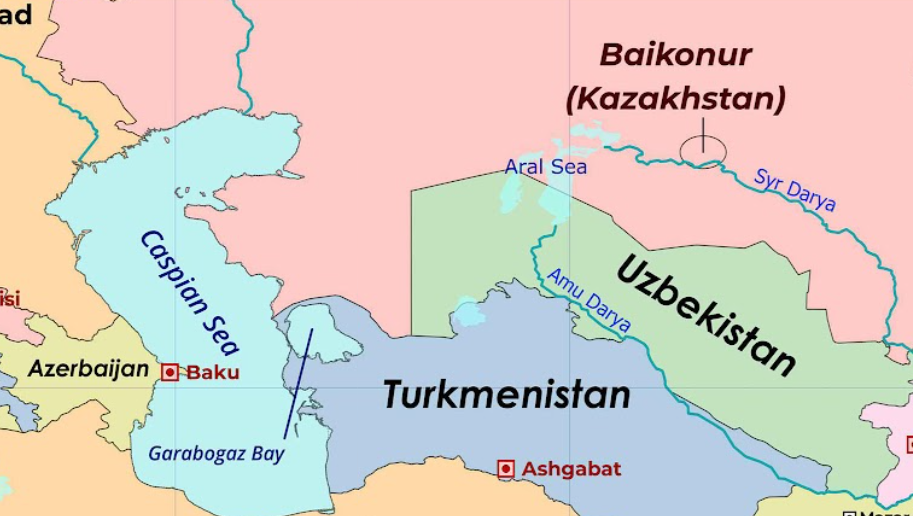
- It is bordered by Kazakhstan on the north and Uzbekistan on the south.
- It was formerly a large saltwater lake.
- Once the fourth largest body of inland water in the world, it lost almost three-quarters of its volume and approximately half of its area.
- It has receded into three separate lakes: the Greater Sea had divided into a long, narrow, western lake and a larger, broader, eastern lake, with the remains of the Lesser Sea to the north.
- Reasons: The drying up of the Aral Sea resulted mainly from the overuse of its two main tributaries—the Amu Darya and the Syr Darya—for irrigation.
Impacts of drying of Aral Sea
- Drying up of the lake caused salt concentrations of the remaining water to rise drastically which killed off the once-abundant supplies of freshwater fish & devastated regional fishing industry.
- Salt and residues became airborne as dust storms blew the pollutants as far away as the Himalayas.
- Annual precipitation, already low, dropped even more.
- Winters became longer & colder, and summers hotter & shorter, affecting the growing season.

{Prelims – Sci – Bio – Diseases} Alaskapox
- Context (HT): Alaska’s health department reports first death from Alaskapox.

- Alaskapox virus is a species of the Orthopoxvirus genus.
- The double-stranded-DNA virus comes from the same genus as smallpox, monkeypox & cowpox.
- It was 1st identified in an adult in Fairbanks, Alaska in 2015, and is most common in small mammals.
- Transmission: Through direct contact with skin lesions
- To date, no human-to-human transmission of the virus has been documented.
- Symptoms: Skin lesions (bumps or pustules), swollen lymph nodes and joint and/or muscle pain.




![PMF IAS Environment for UPSC 2022-23 [paperback] PMF IAS [Nov 30, 2021]…](https://pmfias.b-cdn.net/wp-content/uploads/2024/04/pmfiasenvironmentforupsc2022-23paperbackpmfiasnov302021.jpg)


